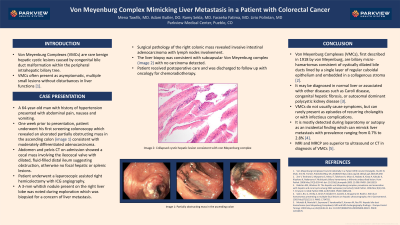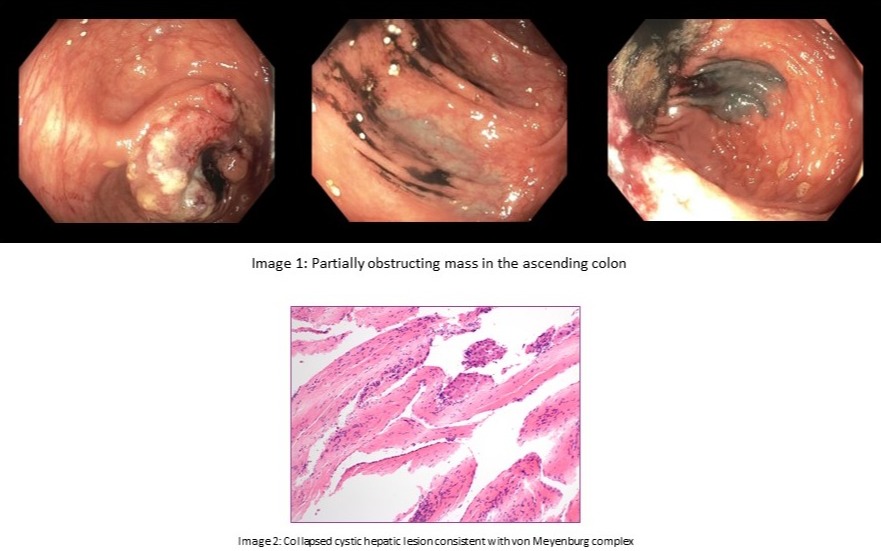Tuesday Poster Session
Category: Liver
P3976 - Von Meyenburg Complex Mimicking Liver Metastasis in a Patient With Colorectal Cancer
Tuesday, October 24, 2023
10:30 AM - 4:00 PM PT
Location: Exhibit Hall

Has Audio

Mena Tawfik, MD
Parkview Medical Center
Pueblo, CO
Presenting Author(s)
Mena Tawfik, MD, Adam Butler, DO, Ramy Sekla, MD, Faraeha Fatima, MD, Lirio Polintan, MD
Parkview Medical Center, Pueblo, CO
Introduction: Von Meyenburg Complexes (VMCs) are rare benign hepatic cystic lesions caused by congenital bile duct malformation within the peripheral intrahepatic biliary tree. VMCs often present as asymptomatic, multiple small lesions without disturbances in liver functions. Von Meyenburg Complexes are clinically significant because they may be erroneously confused with liver metastases.
Case Description/Methods: A 64-year-old man with history of hypertension presented with abdominal pain, nausea and vomiting. One week prior to presentation, he underwent his first screening colonoscopy that revealed an ulcerated partially obstructing mass in the ascending colon. A biopsy of the colonic mass was consistent with moderately differentiated adenocarcinoma. On admission, abdomen and pelvis CT showed a cecal mass involving the ileocecal valve with dilated, fluid-filled distal ileum suggesting obstruction, otherwise no focal hepatic or splenic lesions. Patient underwent a laparoscopic assisted right hemicolectomy with ICG angiography. A 3-mm whitish nodule present on the right liver lobe was noted during exploration which was biopsied for a concern of liver metastasis. Surgical pathology of the right colonic mass revealed invasive intestinal adenocarcinoma with lymph nodes involvement. The liver biopsy was consistent with subcapsular Von Meyenburg complex with no carcinoma detected. Patient received postoperative care and was discharged to follow up with oncology for chemoradiotherapy.
Discussion: Von Meyenburg Complexes (VMCs), first described in 1918 by von Meyenburg, are biliary micro-hamartomas consistent of cystically dilated bile ducts lined by a single layer of regular cuboidal epithelium and embedded in a collagenous stroma. They may be diagnosed in normal liver or associated with other diseases such as Caroli disease, congenital hepatic fibrosis, or autosomal dominant polycystic kidney disease. VMCs do not usually cause symptoms, but can rarely present as episodes of recurring cholangitis or with infectious complications. They are mostly detected during laparotomy or autopsy as an incidental finding with prevalence ranging from 0.7% to 2.8%. However, with the recent advent of noninvasive imaging modalities, VMCs can now be diagnosed in non-surgical clinical practice. MRI and MRCP are superior to ultrasound or CT in diagnosis of VMCs. Clinicians awareness of this clinicopathologic entity and histological examination are necessary to differentiate VMCs from other cystic liver lesions and/or metastasis.

Disclosures:
Mena Tawfik, MD, Adam Butler, DO, Ramy Sekla, MD, Faraeha Fatima, MD, Lirio Polintan, MD. P3976 - Von Meyenburg Complex Mimicking Liver Metastasis in a Patient With Colorectal Cancer, ACG 2023 Annual Scientific Meeting Abstracts. Vancouver, BC, Canada: American College of Gastroenterology.
Parkview Medical Center, Pueblo, CO
Introduction: Von Meyenburg Complexes (VMCs) are rare benign hepatic cystic lesions caused by congenital bile duct malformation within the peripheral intrahepatic biliary tree. VMCs often present as asymptomatic, multiple small lesions without disturbances in liver functions. Von Meyenburg Complexes are clinically significant because they may be erroneously confused with liver metastases.
Case Description/Methods: A 64-year-old man with history of hypertension presented with abdominal pain, nausea and vomiting. One week prior to presentation, he underwent his first screening colonoscopy that revealed an ulcerated partially obstructing mass in the ascending colon. A biopsy of the colonic mass was consistent with moderately differentiated adenocarcinoma. On admission, abdomen and pelvis CT showed a cecal mass involving the ileocecal valve with dilated, fluid-filled distal ileum suggesting obstruction, otherwise no focal hepatic or splenic lesions. Patient underwent a laparoscopic assisted right hemicolectomy with ICG angiography. A 3-mm whitish nodule present on the right liver lobe was noted during exploration which was biopsied for a concern of liver metastasis. Surgical pathology of the right colonic mass revealed invasive intestinal adenocarcinoma with lymph nodes involvement. The liver biopsy was consistent with subcapsular Von Meyenburg complex with no carcinoma detected. Patient received postoperative care and was discharged to follow up with oncology for chemoradiotherapy.
Discussion: Von Meyenburg Complexes (VMCs), first described in 1918 by von Meyenburg, are biliary micro-hamartomas consistent of cystically dilated bile ducts lined by a single layer of regular cuboidal epithelium and embedded in a collagenous stroma. They may be diagnosed in normal liver or associated with other diseases such as Caroli disease, congenital hepatic fibrosis, or autosomal dominant polycystic kidney disease. VMCs do not usually cause symptoms, but can rarely present as episodes of recurring cholangitis or with infectious complications. They are mostly detected during laparotomy or autopsy as an incidental finding with prevalence ranging from 0.7% to 2.8%. However, with the recent advent of noninvasive imaging modalities, VMCs can now be diagnosed in non-surgical clinical practice. MRI and MRCP are superior to ultrasound or CT in diagnosis of VMCs. Clinicians awareness of this clinicopathologic entity and histological examination are necessary to differentiate VMCs from other cystic liver lesions and/or metastasis.

Figure: Image 1: Partially obstructing mass in the ascending colon
Image 2: Collapsed cystic hepatic lesion consistent with von Meyenburg complex
Image 2: Collapsed cystic hepatic lesion consistent with von Meyenburg complex
Disclosures:
Mena Tawfik indicated no relevant financial relationships.
Adam Butler indicated no relevant financial relationships.
Ramy Sekla indicated no relevant financial relationships.
Faraeha Fatima indicated no relevant financial relationships.
Lirio Polintan indicated no relevant financial relationships.
Mena Tawfik, MD, Adam Butler, DO, Ramy Sekla, MD, Faraeha Fatima, MD, Lirio Polintan, MD. P3976 - Von Meyenburg Complex Mimicking Liver Metastasis in a Patient With Colorectal Cancer, ACG 2023 Annual Scientific Meeting Abstracts. Vancouver, BC, Canada: American College of Gastroenterology.
